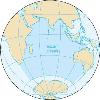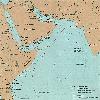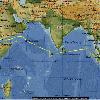

The Indian Ocean is the third largest of the world s five oceans after the Pacific Ocean and Atlantic Ocean but larger than the Southern Ocean and Arctic Ocean Four Tags: Indian Ocean View |
Indian Ocean Dhow Ports 1976 167K Tags: Indian Ocean View |
Tags: Indian Ocean View |
|||||||||
Tags: Indian Ocean View |
Indian Ocean is the third largest of the worlds oceanic divisions, covering about 20% of the water on the Earths surface. It is bounded on the north by South Asia; on the west by East Africa; on the east by Indochina, the Sunda Islands, and Australia; and on the south by the Southern Ocean (or, depending on definition, by Antarctica). It is the only ocean to be named after the name of a country, i.e India.
As one component of the interconnected global ocean (World Ocean), the Indian Ocean is delineated from the Atlantic Ocean by the 20� east meridian (20th meridian east) running south from Cape Agulhas, and from the Pacific (Pacific Ocean) by the meridian of 146�55 east. The northernmost extent of the Indian Ocean is approximately 30� north (30th parallel north) in the Persian Gulf. The Indian Ocean has asymmetric ocean circulationCitation neededdate=June 2009. This ocean is nearly 10,000 kilometres (6,200 mi) wide at the southern tips of Africa and Australia; its area is 73,556,000 square kilometres (28,400,000 mi2), including the Red Sea and the Persian Gulf. The oceans volume is estimated to be 292,131,000 cubic kilometres (70,086,000 mi3). Small islands dot the continental rims. Island nations (Island country) within the ocean are Madagascar, the worlds fourth largest island; Reunion Island; Comoros; Seychelles; Maldives; Mauritius; and Sri Lanka. The archipelago of Indonesia borders the ocean on the east. The oceans importance as a transit route between Asia and Africa has made it a scene of conflict. Because of its size, however, no nation successfully dominated most of it until the early 1800s when the United Kingdom controlled much of the surrounding land.
region.




